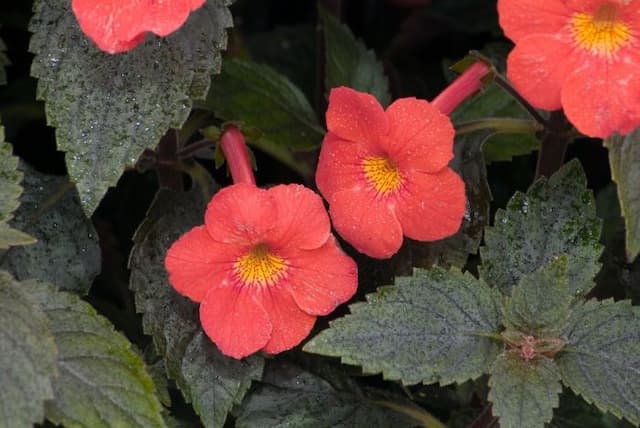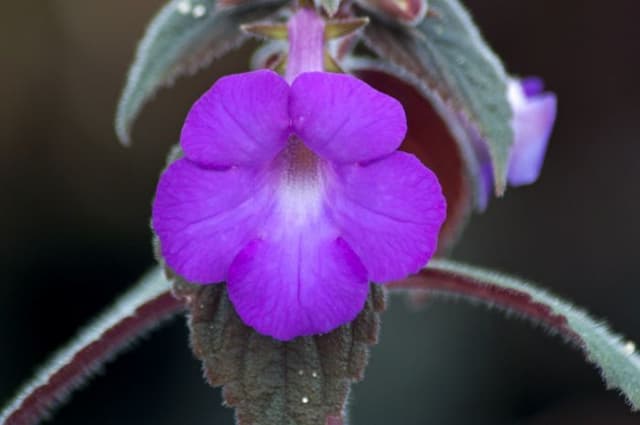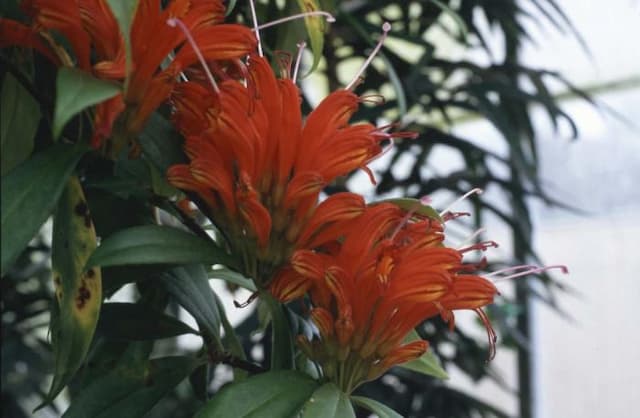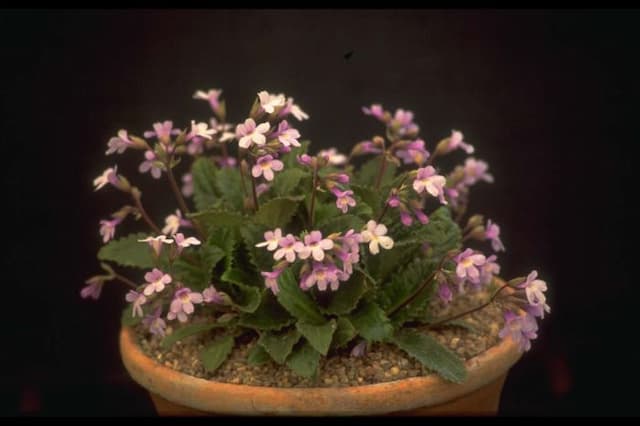Cape Primrose Streptocarpus 'Hannah'

ABOUT
Streptocarpus 'Hannah', commonly known as Cape Primrose, showcases a rosette formation with long, narrow leaves that are soft and velvety to the touch. These leaves are usually deep green in color, forming a lush and dense foliage. Perched atop slender stems rising from the rosette, the Cape Primrose bears trumpet-shaped flowers which display a striking contrast of colors. The petals are often a vivid blue or violet, with a throat that typically has a yellow or white center, often adorned with intricate veins or streaks that provide an additional layer of visual interest. These blossoms are known for their delicate and graceful appearance, exuding a sense of softness and elegance. The blossoms are typically arranged in a loose cluster, giving the impression of a small bouquet emerging from the foliage. Overall, the appearance of Streptocarpus 'Hannah' is marked by its lush leaves and attractive, colorful blooms that give it a distinctive and charming presence in any plant collection.
About this plant
 Names
NamesFamily
Gesneriaceae.
Synonyms
Cape Primrose, African Violet, Twisted Seed Plant.
Common names
Streptocarpus 'Hannah'.
 Toxicity
ToxicityTo humans
Cape primrose (Streptocarpus 'Hannah') is not considered toxic to humans. There are no significant symptoms of poisoning associated with ingestion of this plant, as it's generally seen as non-toxic. Therefore, ingesting parts of the Cape primrose typically should not result in any harmful consequences.
To pets
Cape primrose (Streptocarpus 'Hannah') is also not considered toxic to pets. There are no notable symptoms of poisoning related to this plant. Ingesting parts of Cape primrose is not expected to cause any adverse health issues in pets such as dogs and cats.
 Characteristics
CharacteristicsLife cycle
Perennials
Foliage type
Evergreen
Color of leaves
Green
Flower color
Varies
Height
0.5 feet (15 cm)
Spread
1 feet (30 cm)
Plant type
Herb
Hardiness zones
10
Native area
Africa
Benefits
 General Benefits
General Benefits- Easy to care for: Streptocarpus, also known as Cape Primrose, is known for being low-maintenance and easy to grow, making it suitable for beginners.
- Long blooming period: Cape Primrose can bloom for several months with the right care, providing a long-lasting display of flowers.
- Variety of colors: Streptocarpus 'Hannah' offers a range of colors, making it a versatile choice for home decor.
- Compact size: This plant tends to remain compact, which makes it ideal for small spaces or as a desk plant.
- Attracts pollinators: When grown outdoors, the flowers can attract pollinators like bees and butterflies, benefiting the garden ecosystem.
 Medical Properties
Medical PropertiesThis plant is not used for medical purposes.
 Air-purifying Qualities
Air-purifying QualitiesThis plant is not specifically known for air purifying qualities.
 Other Uses
Other Uses- Photography prop: Streptocarpus 'Hannah' has vibrant flowers that make it an attractive subject for photographers looking for natural beauty to capture.
- Educational tool: Its growth pattern can be used to teach principles of botany and plant biology in classroom settings.
- Art inspiration: The unique appearance of Streptocarpus 'Hannah' can serve as an inspiration for artists and designers looking for organic shapes and colors.
- Feng shui enhancement: This plant could be incorporated into feng shui practices to add a sense of balance and harmony to a space.
- Crafting material: Its leaves and flowers can be used in pressed flower crafts or to create botanical prints.
- Color dye: The pigments in the flowers may be extracted and used as a natural dye for fabrics or paper crafting.
- Culinary decoration: Although not for consumption, the flowers can be used as non-toxic decoration on cakes and desserts.
- Horticultural competitions: Gardeners might cultivate Streptocarpus 'Hannah' to enter into plant or flower shows for its aesthetic qualities.
- Therapeutic aid: Providing care for Streptocarpus 'Hannah' might serve as a therapeutic activity for individuals seeking stress relief through gardening.
- Seasonal decoration: With its blooms, it can be part of table settings or seasonal decor in places that appreciate its ornamental value.
Interesting Facts
 Feng Shui
Feng ShuiThe Cape Primrose is not used in Feng Shui practice.
 Zodiac Sign Compitability
Zodiac Sign CompitabilityThe Cape Primrose is not used in astrology practice.
 Plant Symbolism
Plant Symbolism- Resilience: Streptocarpus, commonly known as Cape Primrose, often symbolizes resilience as it can bloom for a long period with minimal care.
- Persistence: The plant's ability to thrive with little attention also lends itself to symbolizing persistence, reminding us to keep going despite challenges.
- Hope: Its bright and long-lasting flowers offer a symbol of hope, suggesting positivity and looking forward to brighter days.
- Adaptability: Cape Primrose adapts well to indoor environments, representing adaptability in life's various circumstances.
 Water
WaterThe Cape Primrose (Streptocarpus 'Hannah') prefers to be watered when the top inch of soil feels dry. Generally, this means watering it approximately once a week, although the frequency can vary depending on environmental conditions such as light and temperature. When watering, use room temperature water and gently pour it over the soil until it begins to drain from the bottom of the pot, ensuring even moisture throughout the soil without leaving the plant in standing water. Be mindful that overwatering can lead to root rot, so it's important to let the soil dry out slightly between waterings. Depending on the size of the pot and the conditions, you might use around 8-16 ounces of water per week.
 Light
LightCape Primrose (Streptocarpus 'Hannah') thrives in bright, indirect light but can also tolerate moderate light conditions. Avoid placing it under direct sunlight as this can cause leaf burn. An ideal spot would be near an east-facing window that receives gentle morning sunlight or a few feet away from a south-facing window where the light is diffused by sheer curtains.
 Temperature
TemperatureCape Primrose (Streptocarpus 'Hannah') enjoys temperatures between 60-75 degrees Fahrenheit. The plant should not be exposed to temperatures below 50 degrees Fahrenheit as it can damage the plant. Ideally, keep your Cape Primrose in a consistently warm environment without drastic temperature changes and away from cold drafts.
 Pruning
PruningPrune the Cape Primrose (Streptocarpus 'Hannah') primarily to remove dead or yellowing leaves and spent blooms to promote healthy growth and flowering. Pruning can be done as needed throughout the year, whenever you notice fading flowers or leaves, but the best time for major pruning is in late winter or early spring before the new growth begins. This helps the plant conserve energy and encourages more vigorous growth during the growing season.
 Cleaning
CleaningAs needed
 Soil
SoilCape Primrose 'Hannah' prefers well-draining soil rich in organic matter, a potting mix with added perlite and peat moss works well, maintain a pH of 5.5 to 6.5.
 Repotting
RepottingCape Primrose 'Hannah' should be repotted every 12-18 months or when it outgrows its pot to refresh the soil and allow room for growth.
 Humidity & Misting
Humidity & MistingCape Primrose 'Hannah' thrives best in moderate to high humidity levels, ideally between 50% and 60%.
 Suitable locations
Suitable locationsIndoor
Provide filtered light, keep moist, and ensure high humidity.
Outdoor
Shelter from direct sun, protect from frost, moderate watering.
Hardiness zone
10-11 USDA.
 Life cycle
Life cycleCape primrose 'Hannah' begins its life as a seed, which, when sown in well-draining soil and kept at warm temperatures, will germinate. The seedling stage follows, characterized by the emergence of the first true leaves after the initial cotyledon leaves. As the plant enters the vegetative stage, it produces a rosette of large, fuzzy leaves and continues to grow when provided with adequate light, moisture, and nutrition. Upon reaching maturity, Cape primrose 'Hannah' develops flower stalks, bearing trumpet-shaped flowers that vary in color, typically blooming in cycles throughout the spring and summer. After pollination, the flowers will fade, and seed pods may form, containing seeds for the next generation. Throughout its life, which can span several years as a perennial, regular pruning and repotting help maintain the plant's vigor and blooming capability.
 Propogation
PropogationPropogation time
Spring-Early Summer
Streptocarpus 'Hannah', commonly known as Cape Primrose, can be propagated through leaf cuttings, which is the most popular method. This is typically done in spring or early summer when the plant is actively growing. A healthy, mature leaf is selected and cut across the main vein; the cutting, which should be about 2 to 3 inches (5 to 7.6 centimeters) in length, is then laid flat on a moist potting mix. Enclosing the pot in a plastic bag to create a mini-greenhouse effect can hasten rooting. Within a few weeks to a month, the leaf cutting should form new shoots at the vein cuts, which then develop into individual plants that can be separated and potted on their own.









